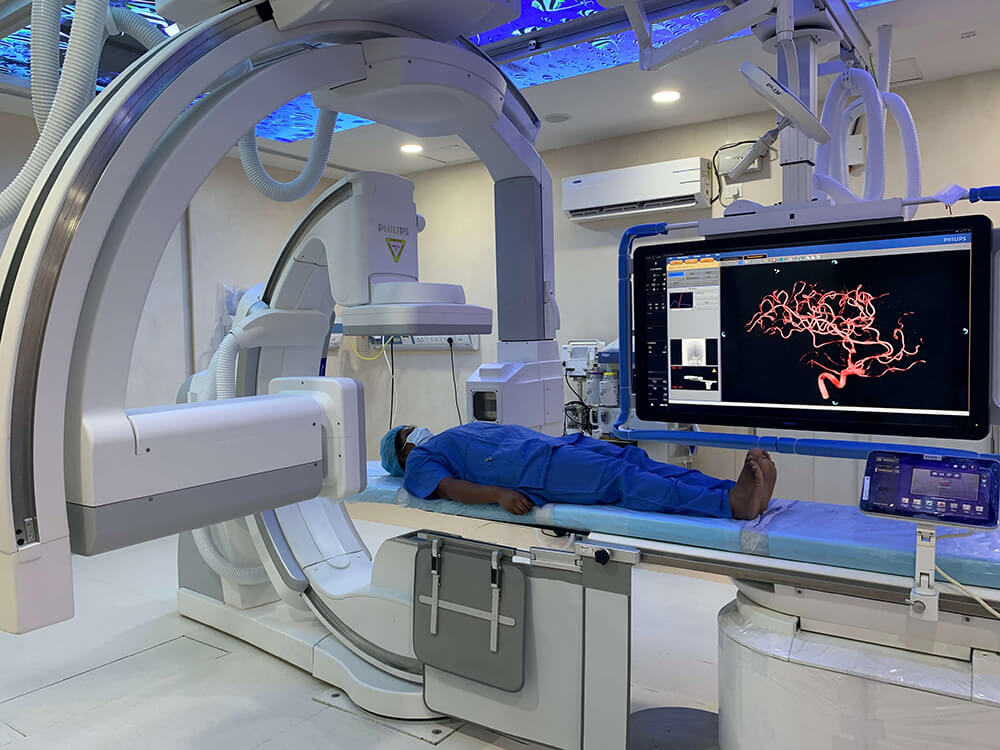
What is Interventional Radiology?
In interventional radiology (also called IR), doctors use medical imaging to guide minimally invasive surgical procedures that diagnose, treat, and cure many kinds of conditions. Imaging modalities used include fluoroscopy, MRI, CT, and ultrasound. At UVA Health System, these radiologists work in the department of vascular and interventional radiology.
Why Interventional Radiology?
Interventional radiology reduces cost, recovery time, pain, and risk to patients who would otherwise need traditional open surgery. Because of this, IR has become the primary way to treat many types of conditions. The treatments IR can effectively perform are ever-changing and expanding.
Treatments done by Interventional Radiology
Blood vessel disease -
Arteries
Narrowing of arteries: leading to restricted blood flow (peripheral vascular disease): Interventional radiologists treat this by using balloons to stretch the vessel (balloon angioplasty, PTA) and sometimes metal springs called stents to hold them open.
Sometimes arteries or bypass grafts block suddenly with a rapid loss of blood supply to the limb. Unless the blood supply is restored this can lead to amputation. Interventional radiologists can help by infusion of clot busting drugs directly into the artery via small catheters thus saving many limbs.
Expanded arteries: at risk of rupture and bleeding: IRs treat these by relining the vessel with a tube called a stent graft.
Bleeding (haemorrhage). This is the most common vascular emergency treated by IR. Haemorrhage can come from almost anywhere e.g. from the gut, secondary to major injury or following birth. Bleeding can often permanently be stopped by blocking the vessel (embolization), relining the vessel with a stent graft or by blowing up a balloon in the vessel to stop the bleeding until emergency surgery can be performed.
Interventional radiology is also used to prevent bleeding during some sorts of surgery e.g. during caesarean section in patients with a high risk of bleeding from an abnormal placenta (post partum haemorrhage).
Veins
Blood clots in the lung: interventional radiologists perform 2 different forms of treatment, placement of devices (inferior vena cava filters) to capture blood clots before they reach the lung preventing further PE. When there is a massive PE causing collapse an interventional radiologist may use small catheter tubes to break up the blood clot and restore blood flow.
Dilated veins (varicose veins): these most commonly occur in the legs but can occur in the pelvis or scrotum. These can be treated by blocking the vein by heat treatment (laser or microwave) or by the use of irritant drugs and embolisation techniques.
Non vascular intervention
This is sometimes referred to as interventional oncology but the treatments are also effective in benign conditions. IR therapies are used for the following:
- to treat the tumour / cancer (tumour ablation, embolization)
- to relieve the effects of the cancer on other systems e.g. blockage of the gullet (oesophagus), bowel, kidney (nephrostomy) or liver (biliary drainage)
- To drain collections of fluid or pus in the chest or abdomen
- To place feeding tubes (gastrostomy, jejunostomy)
- To treat collapsed spinal bones (vertebroplasty)
Tumour therapies: these treatments are intended to shrink or destroy tumours at their primary site or which have spread to other areas (metastases). This is an area of increasing interest and leading to improved survival with reduced morbidity.
Liver, kidney and other tumours (e.g. bone, lung): these can be treated by destructive therapies (ablation) usually involving heat (radiofrequency, laser, microwave, ultrasound) or cold damage (cryotherapy). The treatment is performed and monitored using imaging (ultrasound, computed tomography or magnetic resonance imaging).
Stone Disease
Kidney stones are not uncommon and cause pain, infection and blockage of the kidney. Obstruction of the kidney in the presence of infection will rapidly cause irreversible kidney damage. Interventional techniques include placing a tube in the kidney (nephrostomy) to allow the urine to drain and removing the stones using a variety of instruments placed through the skin into the kidney.

 WhatsApp
WhatsApp